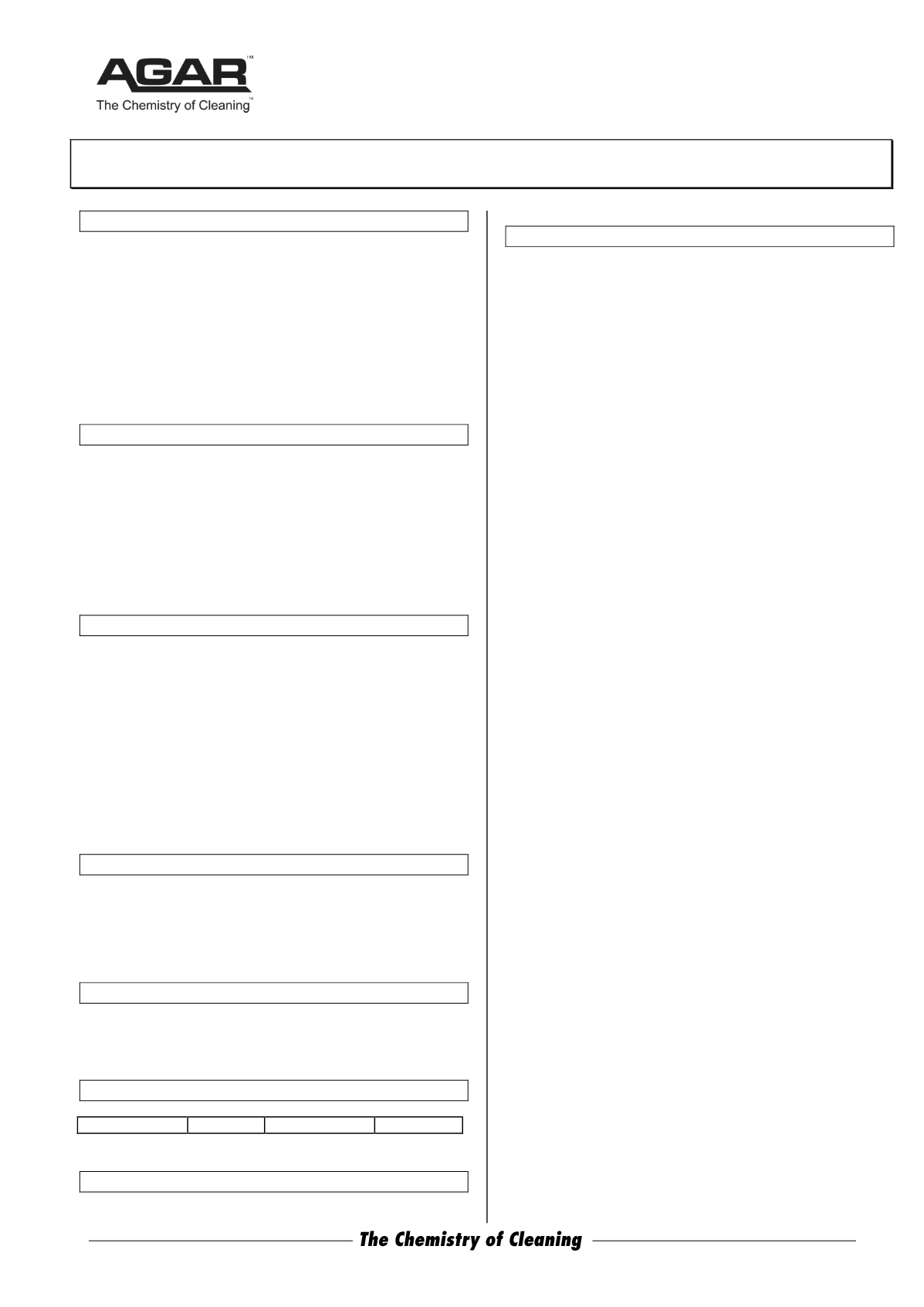

ABN 80 004 726 890 | MADE IN AUSTRALIA
Safety Data Sheet
Issued: June 1, 2014
Page 2 of 2
HOOK ACID
9 PHYSICAL AND CHEMICAL PROPERTIES
Appearance: Clear, green liquid.
Odour: None
pH = 0.0 – 1.0
Vapour Pressure: N/K
Vapour Density: N/K
Boiling Point: N/K
Freezing Point: < 0
°
C
Solubility in water: Infinitely miscible
Specific Gravity: 1.31 (20
°
C)
Evaporation rate: As water
% VOC’s by vol: nil
10 STABILITY AND REACTIVITY
Hook Acid is stable.
Hook Acid and its solutions will etch and damage aluminium,
zinc, diecast and other soft metal alloys as well as concrete,
cement, terrazzo, limestone and marble. Hook Acid should not
be allowed to come into contact with these materials.
Hazardous polymerization: Will not occur.
Reactivity: Hook Acid may react with strong oxidising agents.
11 TOXICOLOGICAL INFORMATION
Health Effects:
Acute -
Swallowed:
Moderately corrosive – causes burns and
desquamation to the mouth, oesophagus and stomach.
Eye:
Moderately corrosive – causes burns and desquamation.
Skin:
Moderately corrosive. Severe irritant to the skin.
Inhaled:
Moderately irritative. Moderately corrosive – causes
burns and desquamation to the respiratory tract (including
mucous membranes, throat and lungs).
Health Effects -
Chronic
: Prolonged or repeated skin contact
may be corrosive to human tissue.
12 ECOLOGICAL INFORMATION
Ecotoxicity: No data available.
Persistence and degradability: -
Mobility: -
Advice: Prevent release to waterways. Contain spills by
absorbing with sand or earth and then placing in plastic drums.
13 DISPOSAL CONSIDERATIONS
For disposal, refer to State Land Waste Management Authority.
14 TRANSPORT INFORMATION
UN No.: 3264
Class: 8 Packg.Group: III Hazchem: 2X
15 REGULATORY INFORMATION
Poisons Schedule Number: Schedule 6
16 OTHER INFORMATION
AICS Listing:
All components of Hook Acid are listed on the
Australian Inventory of Chemical Substances (AICS).
Date: This SDS issued on June 1, 2014 shall remain valid for 5
years unless a new SDS is issued in the meantime. Please
contact Agar Cleaning Systems P/L to ensure you have the
latest version of this product’s SDS.
Abbreviations and Definitions of terms used:
<
less than
>
greater than
AICS
Australian Inventory of Chemical
Substances
CAS
Chemical Abstracts Service (Registry
Number)
COD Chemical Oxygen Demand
deg C Degrees Celsius
g
gram
g/L grams per litre
HSIS
Hazardous Substance Information System
kg
kilogram
L
Litre
LC50
The concentration of a material (inhaled)
that will be lethal to 50% of the test animals.
LD50
The dose (swallowed all at once) which is
lethal to 50% of a group of test animals.
m3
Cubic metre
mg
milligram
mg/m3 milligrams per cubic metre
miscible A liquid that mixes homogeneously with
another liquid
N/A
Not applicable
N/K
Not Known
NIOSH
National Institute for Occupational Safety
and Health
non-haz Non- hazardous
PEL
Permissible Exposure Limit
ppb
Parts per billion
ppm Parts per million
STEL Short term exposure limit
TLV
Threshold Limit Value
TWA
Time Weighted average
UN
United Nations (Number)
wt
weight
The information in this Data Sheet is based on our present
knowledge. However, this shall not constitute a guarantee for
any specific product features and shall not establish a legally
valid contractual relationship. Agar Cleaning Systems accepts
no tortious or contractual liability for any loss or damages
suffered as a consequence of reliance on the information and
advice contained herein.
End of SDS.


















